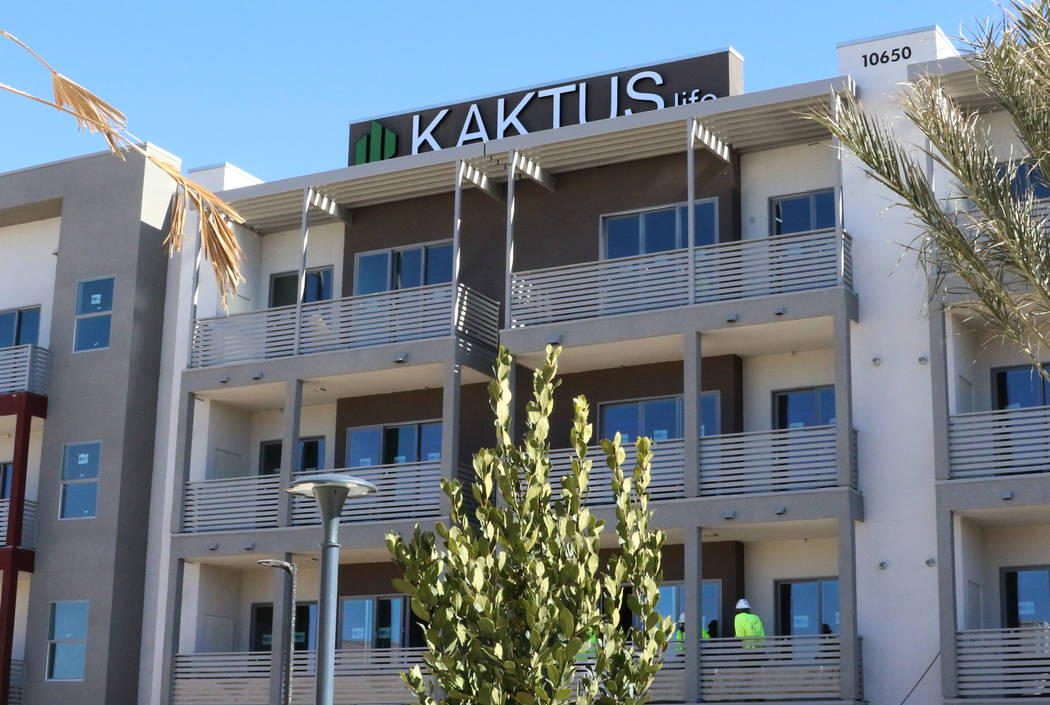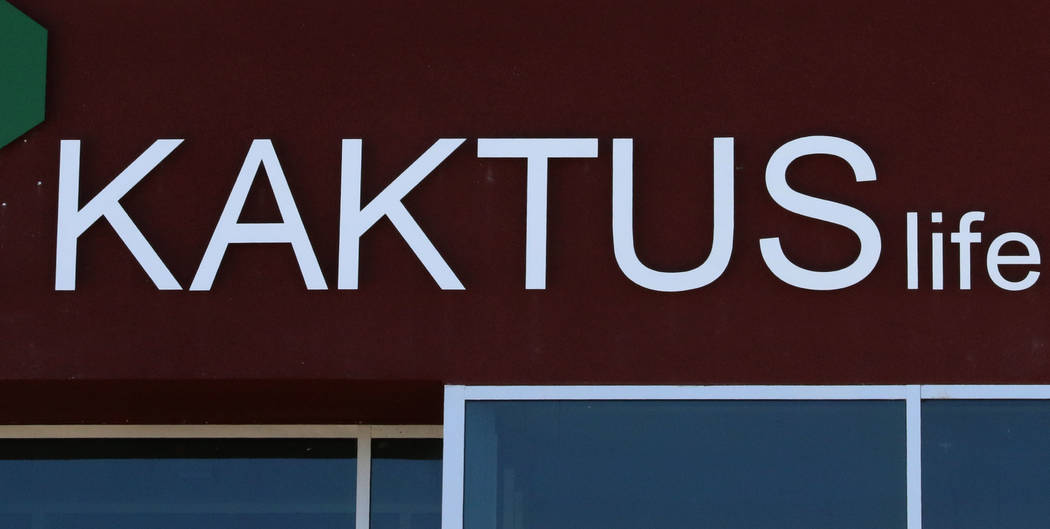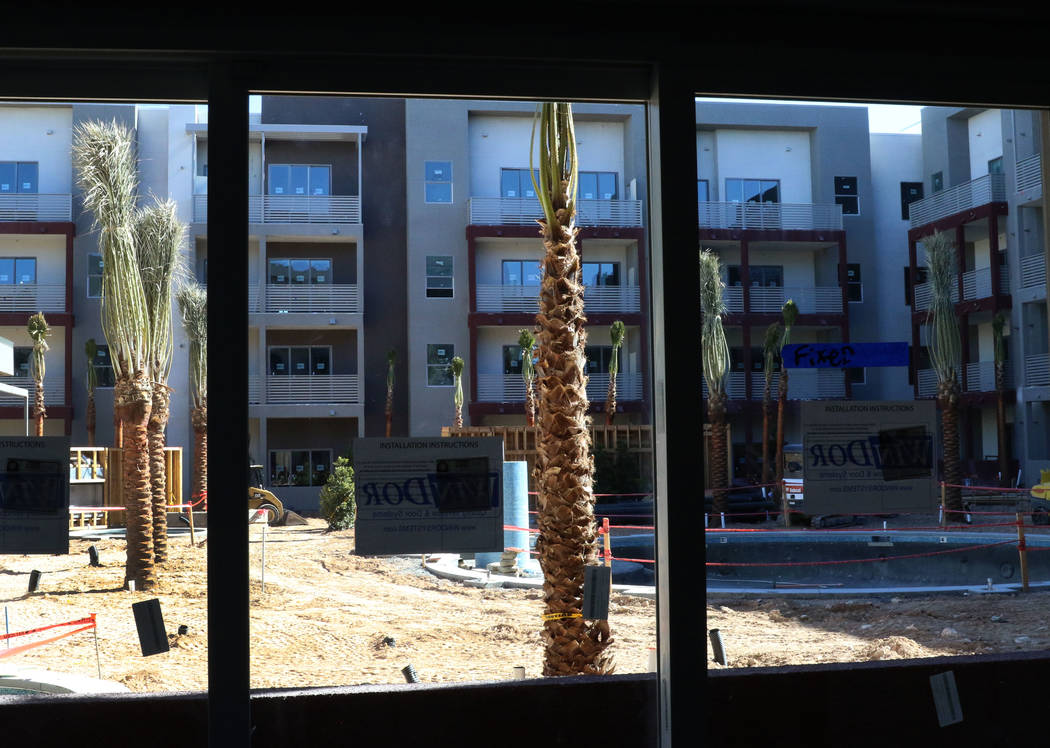Las Vegas luxury apartment complex to open in April
Developers have packed the Las Vegas suburbs with apartments in recent years, and the design of choice has largely been “garden style,” or several small buildings spread around a site.
Similar to his competitors, Tru Development Co. founder Tim Deters is building in the suburbs and offering plenty of amenities at his Kaktus Life rental project in the south valley. But as a mid-rise, the design is different than most.
Kaktus Life is a 210-unit, four-story building with elevators and a resort-style pool in the courtyard. The luxury project at 10650 Dean Martin Drive, off Cactus Avenue and Interstate 15, also features 21,600 square feet of commercial space in four freestanding buildings.
Deters said the commercial space is built, and he expects to finish the apartment building next month, with tenants arriving in April.
The rents aren’t cheap. He estimates the average cost of a one-bedroom apartment there will be $1,600 to $1,700 per month. By comparison, tenants paid an average of $1,059 per month last quarter for a Las Vegas-area apartment, according to research firm Reis Inc.
Deters, a 48-year-old Illinois native, led the now-defunct Las Vegas firm NAC Development Co. before he launched Tru in 2014. He recently met with the Las Vegas Review-Journal at Kaktus Life.
This interview has been edited for space and clarity.
Why did you do a mid-rise complex, and why aren’t more developers building them? Is it because of the cost?
A mid-rise is more expensive. You’re delivering larger corridors, temperature-controlled corridors, elevators. This also adds the mixed-use component, which a lot of garden-style projects don’t do. I had it approved for a garden-style, but a mixed-use overlay was adopted, and I saw an opportunity to create a higher density. There were design and financial reasons. As land prices go up and construction costs go up, the best way to offset that is density. You have to build more units, create more revenue.
You announced more than a year ago that you obtained a $41.5 million construction loan from Goldman Sachs. Was it difficult to get financing for this project?
Yeah, it was. It was challenging because it’s a new product type in the market. There’s not a lot of competition, not a lot of examples.
So that would make lenders nervous?
A little bit. It was more the forecasted rents and the product type that we had to justify through an appraisal. Most people will sit back and just look at general information online and say the rents in this area don’t justify this building. Once they understand the difference (between a garden-style project and a mid-rise), then you go outside this area and identify similar properties that are successful and show them these rents are achievable, this product type does work, these amenities are sought after.
Seeing all the apartment construction, especially in areas like the southwest valley and Henderson, have you been worried that developers are overbuilding?
Not at all. Since Las Vegas started building out of the recession, the demand has been about twice the supply we’re delivering. There’s not enough apartments here. That’s the bottom line.
Are you worried, because there’s still so much construction, about your ability to get tenants and keep rental rates high enough to cover your debt payments? Are those issues you’re thinking about?
We think about them, but am I worried about them? No. I stay close to the market and factors like jobs and population growth, but I also study our competition. It’s an easy test: What’s the absorption? When you see projects throughout the valley leasing 40, 50 units a month, it tells you the demand is heavy.
Developers tell me that, like everything else in Las Vegas, the apartment market was overbuilt during the mid-2000s bubble, then it evaporated and now it’s accelerated.
When you really look into the numbers, when the market went down, multifamily was by far the most consistent in occupancy. Retail places were closing left and right, office buildings were vacant, industrial hubs were vacant, but apartments were pretty full throughout the worst of times in Vegas. That gives me a lot of confidence.
What did you do during the recession? How did you ride it out?
I didn’t develop. I worked for a hard-money lending institution called Integrated Financial Associates. Kept me very active in the market and really showed me the other side of the business.
What happened to your prior company, NAC?
I bankrupted it. We shut it down. That’s why this is a big, big deal for us, for me personally and for my company and for my family. This has been a long road back from the downturn, and this is really the first project under my new company and under the new brand. So we’re very excited about this.
Contact Eli Segall at esegall@reviewjournal.com or 702-383-0342. Follow @eli_segall on Twitter.


























